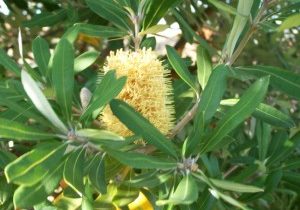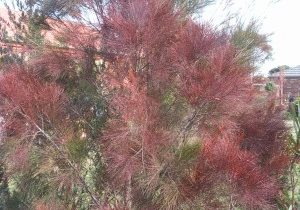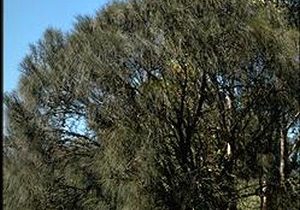List of Drought Tolerant Native Trees |
|
|
|
Botanical name: Allocasuarina torulosa. Common name: Forest oak. Bull oak. Origin and habitat: Eastern Australia. Plant category: Tree Height and spread: A small to medium tree, grows to 15m with a maximum spread between 4 and 6m. Habit and form: A slender tree with deeply ridged and furrowed bark. Clusters of branchlets which function as leaves are slender and drooping. Culture and maintenance: Easy to grow in well drained soils. Do not recover well from severe pruning. Pests and diseases: Relatively pest free, Water usage: Tolerant of a wide range of conditions and will tolerate extended dry periods. Propagation: From seed |
|
|
Botanical name: Allocasuarina verticillata Common name: Drooping She-Oak Name derivation: Syn. Casuarina stricta. Origin and habitat: NSW, VIC, Act, Tas, SA Plant category: Tree Height and spread: A small tree between 4 and 10 m in height with a round crown. Habit and form: Weeping habit with long pendulous branches Culture and maintenance: Easy to grow in well drained soils. Pests and diseases: Relatively pest free, moth borers may attack the trunk, whilst spittle bugs, plant hoppers and coccid gals may be found on the leaves. Water usage: Tolerant of a wide range of conditions and will tolerate extended dry periods. Propagation: From seed Environmental tolerances: It is common in exposed coastal areas. Stands exposure to salt spray. Horticultural usage: Attractive foliage makes this a good street tree |
 |
Botanical name: Banksia integrifolia Common name: Coast Banksia Name derivation: Named after Sir Joseph Banks, the botanist who traveled with Captain Cook in 1770. Cultivars: Prostrate forms are available Origin and habitat: QLD, NSW, VIC, mostly on coastal sands. Plant category: Tree Height and spread: 15 – 20 m tall and 10 – 15 wide Habit and form: Flowers are pale yellow to 14cm long, attractive gray felty underside of leaves. Culture and maintenance: prefers well drained soils and can be easily trained with pruning. Pests and diseases: Assorted moths and loopers may eat the leaves, moth borers can attack the bark. They can be susceptible to Phytopthora root rot, which causes the tree to yellow and die. Water usage: Drought tolerant. Propagation: From seed Environmental tolerances: Tolerant of salt spray, frost hardy. Horticultural usage: Good street tree, good for coastal planting. |
Website by Social Panda | © Copyright of Abben Art. All Rights Reserved 2019


